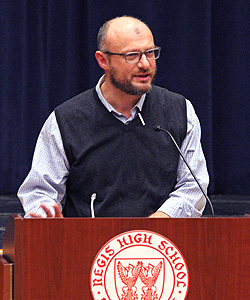Pictured: Dr. Luca Matone teaching a physics class a day after the first detection of a gravitational wave.
 Dr. Luca Matone, a physics teacher at Regis High School, has devoted his career to a little known project called LIGO (the Laser Interferometer Gravitational wave Observatory). That project made headlines on February 11 when it was announced that the observatory had fulfilled its purpose: it "heard" the sound of two black holes colliding light-years away. Because of his past and current contributions to the project, Dr. Matone is among the authors of the detection paper.
Dr. Luca Matone, a physics teacher at Regis High School, has devoted his career to a little known project called LIGO (the Laser Interferometer Gravitational wave Observatory). That project made headlines on February 11 when it was announced that the observatory had fulfilled its purpose: it "heard" the sound of two black holes colliding light-years away. Because of his past and current contributions to the project, Dr. Matone is among the authors of the detection paper.
Dr. Matone first began to work on gravitational wave research as a student. He found it to be "the most exciting field in physics, with many unknowns. I liked the challenge". His initial research began in Italy while earning a Master's degree at Universita di Roma 'Tor Vergata'. From there, he continued his studies in France while earning a PhD at Universite de Paris XI. His efforts eventually led him to assisting in the production of the interferometer at the LIGO observatory in Hanford, Washington. For the past nine years, while continuing his research and interest in the project, Dr. Matone has served as a physics teacher at Regis.
"In my earlier days, I devoted all of my energy to this," said Dr. Matone, reflecting on his career dedication to the project. "I even asked my wife to relocate to the high-desert of Washington State so I could join the team in building the observatory. One of my kids (Caterina) was born there."
"The idea is simple," added Dr. Matone, when asked to explain the discovery. "We proposed building a machine that would allow us to "hear" sounds from the universe; a microphone of sorts. Typical telescopes allow us to "see" the heavens. This one allows us to "hear" the heavens. It can detect loud, cataclysmic events, such as a supernova."
On Sep 14, 2015—the first day of the school year at Regis—LIGO observed a signal that matched one predicted by Einstein's Theory of General Relativity. Two black holes orbited around each other and coalesced to form a new one with a mass equal to less than the combined masses of the original two. The missing mass converted into the energy in the form of a gravitational wave. That wave was detected by the LIGO Observatory and recorded as a sound bite. The simple chirp, as described by The New York Times in their February 11 article announcing the discovery, may be destined to take its place among the greatest sound bites of science.
"The news is humbling," added Dr. Matone. "I am very happy."
Watch: View the video below posted by The New York Times on February 11 explaining the discovery.